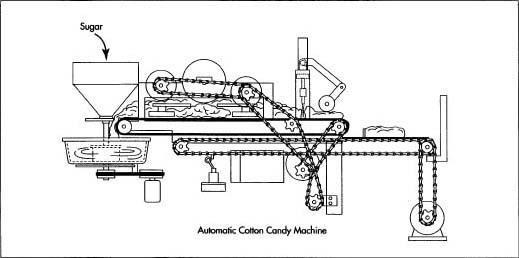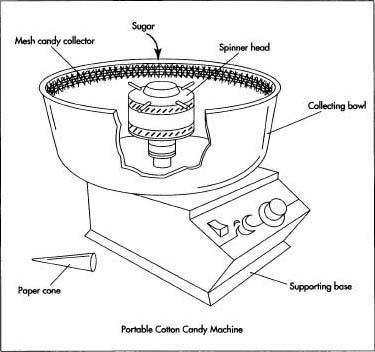Cotton Candy
Cotton candy is a light and fluffy sugar confectionery which resembles cotton wool. It is made by melting a sugar composition and spinning it into fine strands. The strands are then collected on a cardboard tube or bundled in a continuous mass. First developed over 100 years ago, cotton candy remains a favorite summertime candy at carnivals, amusement parks, and baseball stadiums. With the development of more efficient, automated machines it is expected that the market for cotton candy will substantially increase in the coming years.
Background
Cotton candy is a popular food at carnivals and amusement parks. Typically, it is sold as a large mass wrapped around a cardboard cone. It has a fibrous texture that makes it unique among sugar confectioneries. This texture is a direct result of the sugar used to make the candy and the method in which it is processed. At the start of manufacture, the sugar is a solid material supplied as individual granules. When it is melted the individual granules become intermixed and form a thick, sticky syrup. This syrup is then spun out to create thin strands that harden. These hardened strands have many of the same characteristics as cotton fibers, which is how cotton candy got its name. When the strands are collected on a cone, they are not packed close together and a certain amount of air gets trapped between them. This increases the volume of the candy, giving it a light and fluffy texture.
History
Sugar confectioneries have been known for thousands of years, however the development of cotton candy is a relatively recent event. Evidence shows that the first sugar confectioneries were used during the time of the ancient Egyptian civilization. True candymaking began only after a sugar refining process was developed during the fourth century. For many years candy was a luxury item available to only the privileged. Eventually, sugar became more widely available and candy could be enjoyed by all.
The modern candy industry developed during the nineteenth century. At this time, special candymaking machinery was invented. These machines were semi-automatic and allowed production on a large scale. The first cotton candy machine was created during the late nineteenth century. This machine consisted of a large pan with a rotating heating core in the middle. Operators could make individual servings, and since it was portable, it became a popular confection at circuses, carnivals, and ball parks.
Prior to the 1970s, cotton candy was only produced on a small scale. This was due to the fact that there were no automated machines that could produce enough product for widespread distribution. Then, in 1972, an automatic cotton candy manufacturing machine was patented. This machine provided an efficient for automatic manufacture and packaging. It led to the mass production of cotton candy.
Raw Materials
Sugar is the most important ingredient used in the manufacture of cotton candy. Chemically, sugar is known as sucrose, which is a disaccharide, made up of glucose and fructose units. It is obtained primarily from sugarcane

To produce the well-known characteristics of cotton candy, other ingredients such as dyes and flavorings must be added. Since sugar is naturally white, dyes must be added to produce the different colors typical of cotton candy. Usual dyes include Red dye #40, Yellow dye #5, Yellow dye #6, and Blue dye #1. By using only these federally regulated dyes, cotton candy can be made to be almost any color desired. The most popular colors are pink and blue, however purple, yellow, red, and brown cotton candy are also sold.
Cotton candy is available in many different flavors including bubble gum, banana, raspberry, vanilla, watermelon, and chocolate. To produce these flavors, both artificial and natural flavorants may be used. Natural flavors are obtained from fruits, berries, honey, molasses, and maple sugar. Artificial flavors are mixtures of aromatic chemicals produced synthetically via organic reactions. Some important artificial flavoring compounds include materials such as methyl anthranilate and ethyl caproate.
In addition to the cotton candy ingredients, different packaging raw materials are required. Since moisture can make cotton candy rubbery and sticky, the packaging is designed to inhibit interaction with air. Typically, a plastic bag made out of a highmolecular weight polymer is used.
The Manufacturing
Process
There are primarily two types of machines used to produce cotton candy. One of them is semi-automatic and is used to produce the single serve helpings that are immediately sold at carnivals and amusement parks. The other is a fully automated machine that is used to produce large volumes of cotton candy for widespread distribution. Since these machines are very similar, both will be described below.
Sugar processing
-
1 The first step in making cotton candy is converting the granular sugar
into fine filaments. To do this, solid sugar is placed in a large,
stainless steel hopper. This hopper has a tapered bottom, which funnels
the sugar into the extruder. The extruder is a
rotating metal cylinder, which has holes along its sides and is equipped with a heating element.
 The portable cotton candy machine consists of a large pan with a rotating heating core in the middle. Operators make individual servings at popular venues such as the circus, carnival, and ball park.
The portable cotton candy machine consists of a large pan with a rotating heating core in the middle. Operators make individual servings at popular venues such as the circus, carnival, and ball park. - 2 Inside the extruder, the sugar is heated such that it melts and becomes a molten liquid. The spinning extruder then throws the strands of liquid sugar out in all directions through the holes in its sides. As it exits the extruder, the liquid sugar cools and forms solid strands. These strands, which are the fibers used to make cotton candy, are collected in a large circular pan surrounding the extruder. To prevent coagulation of the strands, moisture is minimized during this phase of manufacture.
Candy collection
- 3 In machines that produce a small amount of cotton candy, such as those found at carnivals, the strands of cotton candy are then collected by the machine operator. He takes a cardboard cone and passes it around the sides of the collection pan. As the cardboard is passed around, the sticky sugar strands adhere to it. When enough is collected on the cone, the cotton candy is sold to the consumer immediately. The situation is slightly different for automated cotton candy machines. In these machines, the strands of cotton candy are pulled onto a conveyor belt and transferred into a sizing container. Here the candy strands are combined into a continuous bundle.
- 4 In the sizing container, the bundle of cotton candy is molded into a consistent shape. This is done by rollers that are spaced on the top and sides of the conveyor belt. To prevent the cotton candy from sticking to the rollers, they are typically coated with a non-stick substance such as Teflon. As the candy exits the sizing container, it has the shape of a continuous block with a fixed height and width. This forming process is done with a minimum of force so the candy is not compressed so much that it changes its character or texture.
Cutting
- 5 After the shaping process, the cotton candy is conveyored to a knife blade where it is cut into segments of a set length. The knife is mounted vertically above the conveyor, and as the candy passes by, it slides down to make the cut. The knife is then retracted and the segmented candy is conveyored away. To help the candy maintain its shape and prevent it from sticking to the knife, it is then passed under another roller immediately after it is cut.
Packaging
- 6 The cut mass of cotton candy is next transferred to the packaging machine. Here, it is automatically put into a plastic bag or other type of packaging, and sealed shut. It is important that the package is sealed so moisture is prevented from spoiling the candy. The bags are passed by a coding device where they are marked with information related to the date of production, batch number, and other information. The bags are then carefully put into boxes. The boxes are stacked on wooden pallets, transferred to trucks via forklifts, and shipped to the local supermarket. The entire process from loading the sugar to putting the candy in boxes takes only a few minutes.
Quality Control
As in all food processing facilities, quality control begins with a check of the incoming ingredients. These ingredients are tested in a quality control laboratory to ensure they meet specifications. Tests include evaluation of the ingredient's physical properties such as particle size, appearance, color, odor and flavor. Certain chemical properties of the ingredients may also be evaluated. Each manufacturer has their own tests that help certify that the incoming ingredients will produce a consistent, quality batch of cotton candy.
In addition to ingredient checks, the packaging is also inspected to ensure it meets the set specifications. An important property that is routinely examined is the odor of the packaging. Many times plastics can acquire off-odors during processing. These odors can be passed on to the food products and hence must be found before the packaging can be used. Since excessive water vapor can ruin a bag of cotton candy, the packaging is also checked for its moisture-vapor transmission rate. Other properties that are checked include grease resistance and physical appearance. Correctly produced cotton candy has a shelf life of about six months.
After production, the characteristics of the final product is also carefully monitored. Quality control chemists perform many of the same tests on the final product that they did on the initial ingredients. These include tests of the candy's appearance, flavor, texture, and odor. The usual test method involves comparing the final product to an established standard. For example, to make sure the color is correct, a random sample may be taken and compared to some set standard. Other qualities such as taste, texture and odor may be evaluated by sensory panels. These panels are made up of a group of specially trained people who can determine small differences. In addition to sensory tests, other standard industry instrumental tests may also be performed.
The Future
Cotton candy has changed very little since it was first introduced. Most of the improvements have come in the design of machines that are used to make the candy. It is expected that future improvements will continue to be found in this area. For example, machines will be developed which are more automated with computer controls. These machines will be able to produce the candy more efficiently, economically and safely. In addition to new cotton candy machines, new colors and flavors will also be introduced to make the confection more appealing.
Where to Learn More
Books
Alikonis, J. Candy Technology. Westport, CT: AVI Publishing Co., 1979.
Kirk Othmer Encyclopedia of Chemical Technology. New York: John Wiley & Sons, 1992.
Mathlouthi, M. and P. Reiser, ed. Sucrose: Properties and Applications. London: Blackie and Sons, Ltd., 1995.
Pennington, N. L. and C.W. Baker, ed. Sugar, A User's Guide to Sucrose. New York: Van Nostrand Reinhold, 1990.
— Perry Romanowski